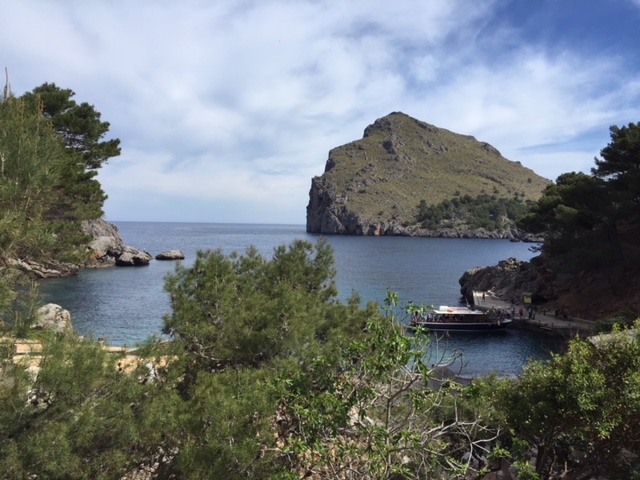As mentioned in the previous post, Mallorca has much to offer and not a huge amount of practical information about the rides. I’ve found a couple of good sites which list the basic rides and their routes, but they also miss a few practical things worth noting.
Sa Calobra: and its approaches, Col de Femenia and Col de Sa Batella:
Let’s start with the biggie, because this is probably the one that you’ve heard of first. SA CALOBRA! Your pal sent you a post-card from his visit and told you it’s the greatest ride ever. That’s why you lobbied to go to Mallorca instead of going to your brother’s cabin for a week and put up with mosquitos in your beer and his insufferable children, the ones who want s’mores but end up flinging flaming petroleum puffs at you because they don’t understand the difference between toasting a marshmallow and incinerating it.
Let’s make this clear right off the bat: Sa Calobra is the Mack Daddy- it’s cool, and totally worth it. There are many good descriptions of the route, ride, and pitch to be found on the internet, so instead of re-hashing them, I’ll add a bit that they leave out.
First off, let’s talk about access. You have 3 approaches: from Pollensa, from Inca, or from Soller. The ride from Pollensa on MA-10 is really nice, over the Coll de Femenia (itself a great ride, by autumn of 2017 the road from Port de Pollensa to about the base of the col was freshly paved), past Lluc, and along past the top of the Col de Sa Batella. Once over the Col de Femenia, the road straightens out , and you will see a few parking areas on both sides of the road. These are trailheads, and it is possible to start your ride there if you have someone along who didn’t devote the time to train for this trip, because they were working, or raising your children while you were out prancing about in Lycra and smelling of chamois cream, or cooking your meals so you weren’t completely hangry, or something to that effect. If you’re relatively intelligent and know how to navigate familial politics, you’ll keep these in mind. Or so I’ve heard, but I really don’t have first-hand experience with this particular issue that I can recall.
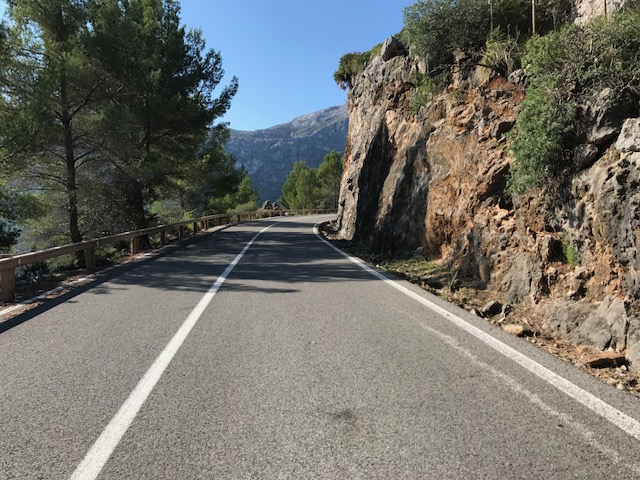
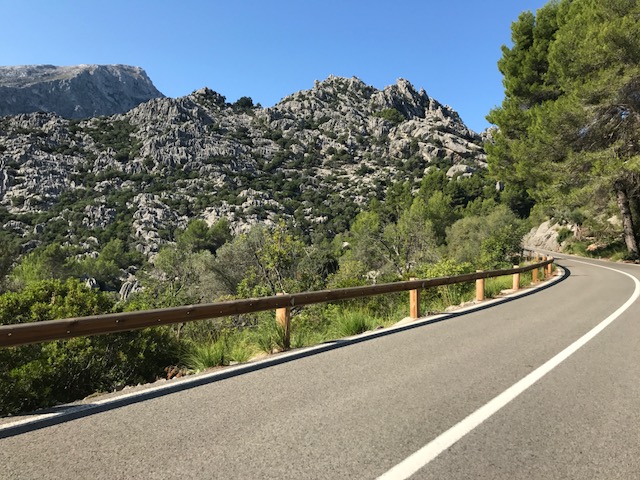
Climbing the Col de Femenia. As you ride, notice the incredible wavy erosion on the hillsides (you’ll see this pattern closely on Sa Calobra as well). The road surface is in tip-top shape.
From Inca, head north through Selva and Caimari and over the Col de Sa Batella. Just north of Selva, the road makes a horseshoe bend around some amazing olive trees. Take a picture. In Caimari, stop at Sa Ruta Verda for a snack before the climb, and make sure that you look at the beautiful canyon as you head up along MA-2130. You can also buy the cycling map mentioned in Part 1, because you’ve been meaning to pick one up.
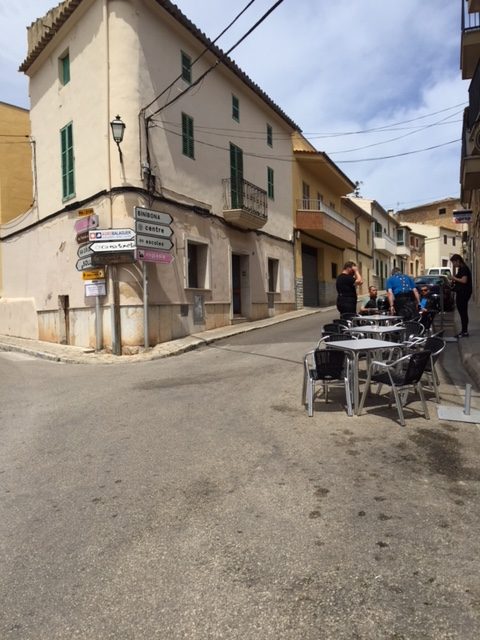
Caimari. Bear left here, go maybe 100 meters to Sa Ruta Verda, located on the right side of the street.
This climb meanders up under large trees which provide dappled shade, cuts through a deep cleft in the rock, contour-lines above a hidden valley to a lovely set of switchbacks, and ends at a gas station.

This is why you stop at Sa Ruta Verda.
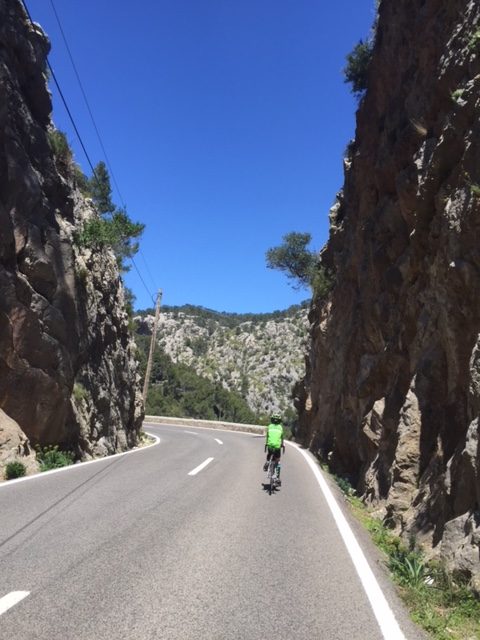
After this gap, the Col de Sa Batella follows a contour line. To the right is a gorgeous hidden valley. After a small rest, the road ramps back up through some well-shaded switchbacks for the final part of the climb.
I haven’t ridden MA-10 between Soller and Sa Calobra, but there’s no reason to think it’s not a great ride. Clearly, I need to return for more research, but the other two approaches are so good, I have a hard time thinking of more variations.
At the top of Sa Batella, there is a restaurant with a nice shaded patio. Feel free to admire it, because the odds you will actually get a table are about the same that monkeys will fly out of your ass and push you up the steep grades. There is also the gas station, where you can get water or a soft drink, which you can sip while you glare at the people sitting on the nice shaded patio.

From Sa Batella, go left at these signs.
Continuing westward, the road rolls up and down. The ramps are pretty short, and just steep enough to sap your legs without you noticing, but you planned for this with your short break at Sa Batella. After a few kms, you will see the road narrow significantly, with a restaurant called Escorca, built into the uphill side, and shortly afterwards, a very nice viewpoint where you can stop for a view, which is the point. Remember this place, because they have spectacular fresh orange juice.
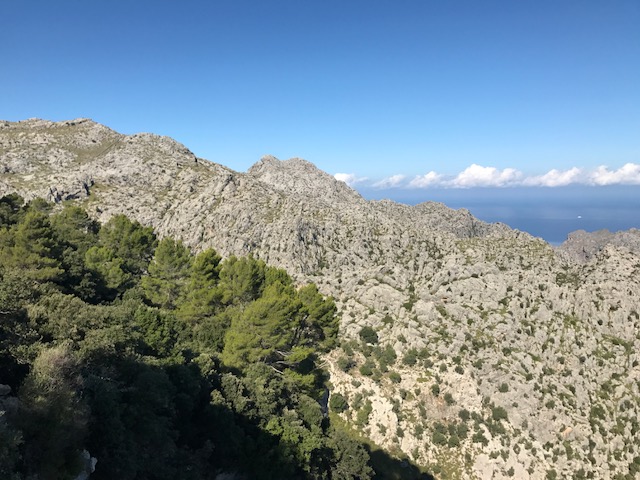
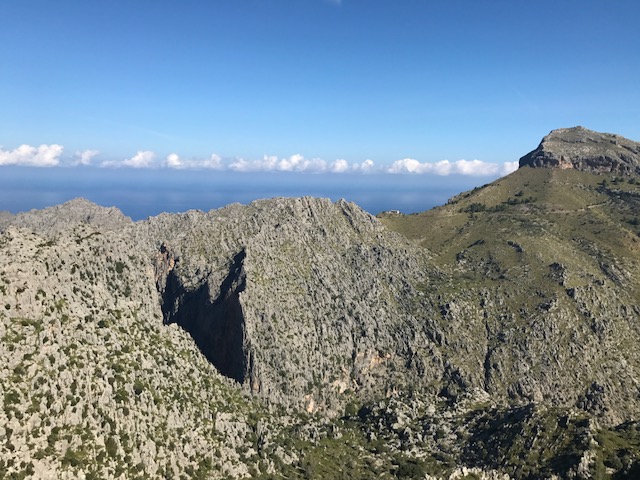
You get the (view)point.
A few more kms, a giant, sweeping curve, and you pass under a series of arches that cross the road.

Turn right here, and immediately come to a halt in a throng of tourists and diesel-belching buses. On your right is a giant tree with a rundown shack underneath, you can get fresh juice here as well, but it’s a little chaotic. Whatever you do, avoid the WC in this place. Seriously. Press forward, because the Coll de Cal Reis beckons. It’s short, at only about 3km, with a few steep ramps to draw your attention. The view is quite nice to the east, and if you keep your eyes peeled, you will probably see goats in the small trees along the roadway. If you do, stop and take a picture, because you’re on vacation, and that’s what you’re supposed to do.

Up and over the top and you begin the long, twisty, and exciting descent that everyone talks about. And, it’s awesome. The famous looping turn at the top begs for you to rail the turn and scream down it at high speed. And scream you will, but not because of velocity. Instead, you need to know there’s a small cafe under the roadway, with parking on the inside of the loop. I’m pretty sure there’s a guy there who’s job is to wait for a cyclist to start bombing down, then he’s supposed to back a rental car out and block both lanes just as you accelerate towards the exit of the turn. If he’s off-shift, there’s a young sunburned couple on a moped willing to take his duties. Basically, take it easy there, or you’ll end up as a hood ornament.
Once you pass the sick cretin who has sapped your momentum, you get to play on what may be the coolest switchbacks ever made. Enjoy them, and stay off your brakes as much as possible, because you have a long descent. If you manage your rim temperatures well, you can smugly wave at the people at the bottom of the hill who are changing tubes (ignore if you’ve gone disc).

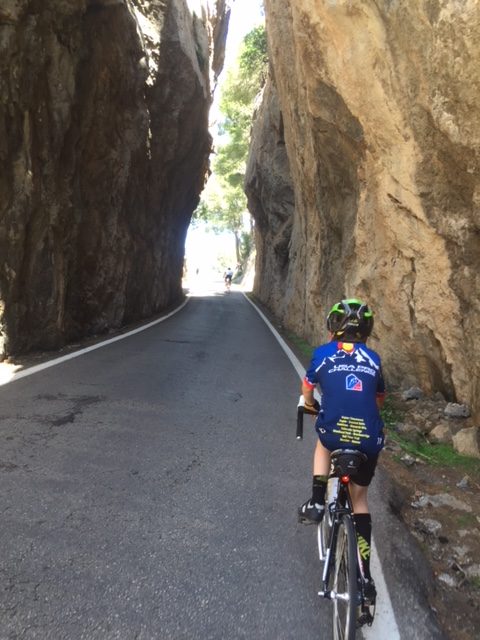
At this choke-point, expect to wait for traffic to thread this gap. The fact that buses make it through is a testament to the driver’s skill.
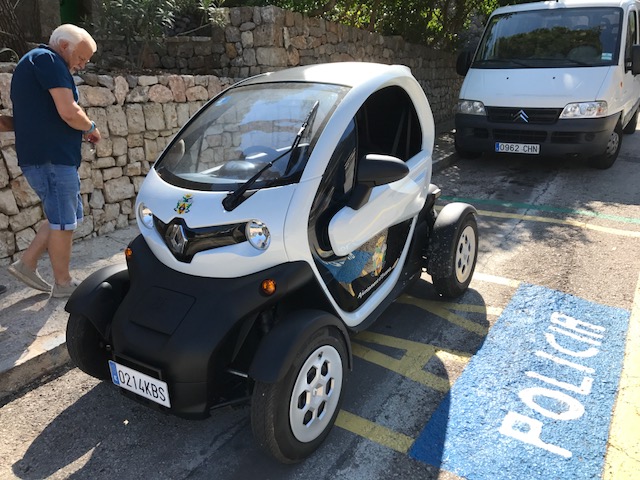
Calobran Cop Car. Chases in this town are epic.
Every website and guide will tell you to go early, and they mean it. Like really early, in the cool of the morning, not the crack-of-10 tourist early. There will be buses, and lots of them, shuttling people down to the ferries, which go to Soller on what I am sure is a lovely cruise. There will also be people in rental cars, many of whom have never driven twisty mountain roads and who have no idea why you would want to downshift on one. Also, there will be MAMILs by the score, and many will treat the centerline of the road as an abstract concept. This is an issue when you are climbing back out, as they will cross into the climbing lane and scream at you for having the audacity to pedal on on the far right of the road.
One thing to know is that the buses will deadhead back up in small caravans, and really, they are very good at giving cyclists space. Smile and wave at them with all five fingers. You can save the single-digit gestures for the people who truly deserve it, but the tour bus drivers are pros and will give you space if they can.
At the bottom, the road straightens and flattens, before a series of road furniture funnels you to the waterfront. Take the time to shift into the small ring/big cog now, because after lunch, you will have forgotten. Speaking of lunch, depending on the status of the ferries, you may have to fight for a table. There are a couple of buffet-line places, and once you have your tray of TouristChow, you’ll have trouble squeezing between the tightly-packed-in tables on the slightly undersized patios. I was unable to discern any difference in food offerings or price between the 2 main restaurants there, so just select one and commit to it.
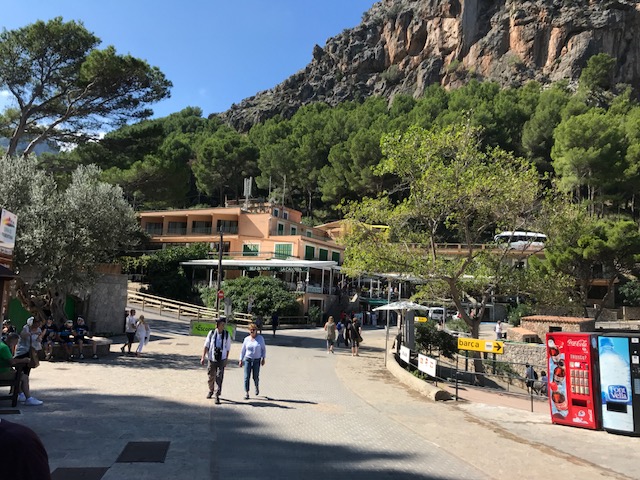
The climb out is really not as horrific as many descriptions would have you believe, particularly at the lower parts, where the gradients are in the 6-8% range. Sa Calobra saves the fun for the top, where you can find double-digit grades. As you climb, you’ll be thinking about that long, slow breakfast you had before getting on the road, because you will quickly realize that the steepest sections of the climb have basically no shade, and the breeze has packed up and headed for the beach to take a well-deserved afternoon off. You’ll really be cooking up that hill, and I don’t mean speed-wise. Keep your eyes out for more goats in trees, screaming descenders in your lane, and the incredible stonework of the roadway itself.
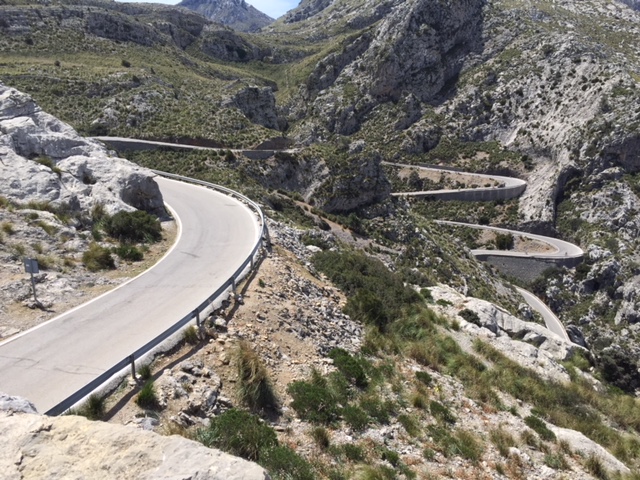
Once back over the Coll de Cal Reis, if you’re heading east, pass the touristy place at the MA-10 intersection and head to Escorca by the viewpoint for a well-deserved fresh OJ. Then, it’s back to either Pollensa or Inca. If you turned right to Soller, turn around, get the OJ, then turn back westward.
